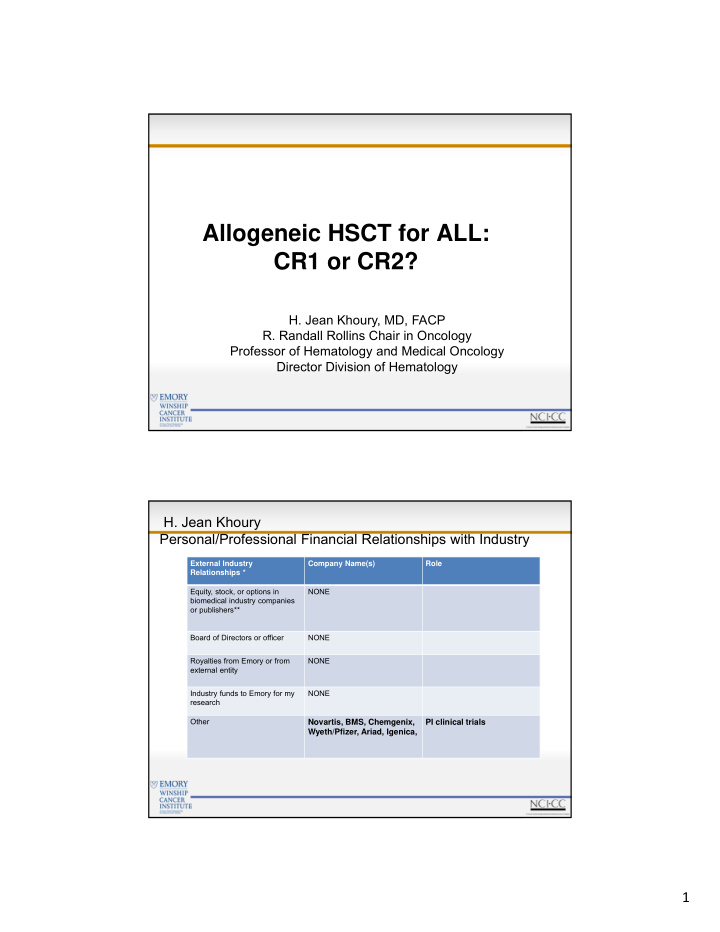



Allogeneic HSCT for ALL: CR1 or CR2? H. Jean Khoury, MD, FACP R. Randall Rollins Chair in Oncology Professor of Hematology and Medical Oncology Director Division of Hematology H. Jean Khoury Personal/Professional Financial Relationships with Industry External Industry Company Name(s) Role Relationships * Equity, stock, or options in NONE biomedical industry companies or publishers** Board of Directors or officer NONE Royalties from Emory or from NONE external entity Industry funds to Emory for my NONE research Other Novartis, BMS, Chemgenix, PI clinical trials Wyeth/Pfizer, Ariad, Igenica, 1
Individualized Medicine ALL High-Risk Low-Risk patients Young Adults HCVAD + R Pediatric Intermediate-Risk Older regimens With CR2 Patient achievable Overall survival: Childhood ALL on St. Jude’s Trials 1962-2007 Pui et al. NEJM 2006 2
Children Pui, et al. NEJM 2004 3
Survival on hyper-CVAD regimen by age Kantarjian et al. JCO 2000 Pieters R & Carroll WL. Ped Clin NA 2008;55:1 ‐ 20 4
CCSG Study 1961: ALL in Young Adult Gp (age 16-21) Nachman JB, et al. JCO 2009;27:5189 Individualized Medicine ALL High-Risk Low-Risk patients Young Adults HCVAD +/- R Pediatric Intermediate-Risk Older regimens With CR2 Patient achievable 5
MRC ‐ UK Outcome of older patients with ALL Study Group # patients aged > 50- CR PFS OS 60 SWOG L-10M 40 35% 8.3 months Median 1 month CALGB 8811 18 (> 60) 39% 12 months Median 1 month GMALL 94 (> 65) 48% NR < 10% ECOG 108 (> 50) NR NR 15% at 5 years MDACC 59 (> 60) 80% NR 17 % at 5 years Individualized Medicine ALL High-Risk Low-Risk patients Young Adults HCVAD +/- R Pediatric Intermediate-Risk Older regimens With CR2 Patient achievable 6
Results of the ALL-R87 trial of 61 adults (median age 28) with relapsed ALL Fiorina et al. Italian cooperative group BJH 1997 34/61 (56%) achieved CR •Only 9 patients were transplanted (5 autologous, 4 allogeneic). •Autografted patients: four relapsed after 1, 3, 4 and 25 months. One is currently in continuous CR (CCR) at 46 months from BMT. •Allografted patients, 1 relapsed 5 months from BMT and 3 are alive in CR at 22, 43, 63 months from BMT. Portell & Avandi. Leuk/Lymp 2014;55:737 7
An open label, multicenter, phase II study to evaluate efficacy and safety of the BiTE antibody blinatumomab in adult patients with relapsed/refractory B-precursor acute lymphoblastic leukemia(ALL) • 220 pts enrolled at last report from ASH : -36 evaluable -26 (72%) CR/Cri w/i 2 cycles—24 molecular resp - Med OS=9.0 mos; 13/26 went to allo SCT - Major toxicities: CNS (seizures; encephalopathy), infection, thrombocytopenia, cytokine release syndrome • Phase I pediatric trial in rel/ref B-ALL reported at ASH 2013 with 34 pts: ORR 41% (CR 35%) Chimeric Antigen Receptors: CARs Autologous T-cells modified to express a surface receptor that mediates binding of the target tumor antigen, e.g., CD19, which in turn activates a signal to the T-cell to induce target cell lysis. a. Single chain variable fragment antibody specific to tumor antigen b. Fused to transmembrane domain and a T-cell signaling moiety, e.g., CD3 zeta or FcR γ 8
CARS in ALL • Chimeric T cells (CTL019) • 16 patients, age 5-22 with rel/ref ALL • CR = 81% (10 of 16 persist up to 16mos) • Continued expansion of CARs in vivo • Persistence of CARs in blood and BM for >6 mos. • CARs found in CSF • Toxicity: Cytokine release syndrome Individualized Medicine ALL High-Risk Low-Risk patients Young Adults HCVAD +/- R Pediatric Intermediate-Risk Older regimens With CR2 Patient achievable 9
Outcomes Adult ALL Durrant et al. MRC. Hem/Onc Clin of N. Am.. 2000 Risk Factors in ALL Elevated BC >30k (B-cell) >100k (T-cell) Cytogenetics t(9;22), t(4;11), t(1;19) & Complex Molecular Hypodiploidy Genetics NOTCH 1 activating mutation BAALC inc expression IKZF1 deletion/mutation Age >35 (a continuum) Time to CR >4 (?6) weeks Molecular failure (MRD) 10
MRD and prognosis in ALL 11
Improving Outcomes • Targeted therapy against MRD: – Monoclonal antibodies – TKI Rituximab-HCVAD 12
Blinatumomab for MRD A: RFS entire group (n= 20) = 61% (12 remain in CR) B: RFS 9 patients receiving HSCT = 65% (6 remain in CR) C: RFS 11 patients no subsequent Rx = 60% (6 remain in CR) f/u 33 mos Topp MS, et al. Blood; 2012;120(26):5185 ‐ 5187) 13
HyperCVAD-Imatinib in Ph+ ALL Thomas et al, Blood 2004, 103:4396-4467 HyperCVAD-dasatinib in Ph+ ALL 14
Treatment options for Relapsed Ph+ ALL Dasatinib Blood. 2007;109:3207-3213 Bosutinib Myeloid BP-CML N=52 MaHR 28% CHR 15% MCyR 37% Ponatinib CCyR 28% Myeloid BP-CML Lymphoid BP-CML N=52 N=10 MaHR 29% 40% Any CyR a 37% 50% MCyR 19% 40% CCyR 15% 30% Goldstone AH, et al. Blood 2008;111:1827 ‐ 33 15
Goldstone AH, et al. Blood 2008;111:1827 ‐ 33 0.02 Goldstone AH, et al. Blood 2008;111:1827 ‐ 33 16
Post-Transplant Rituximab BLOOD, 22 AUGUST 2013 x VOLUME 122, NUMBER 8 17
Conclusions • Landscape for adult ALL is changing • Monoclonal antibodies and TKIs – upfront, post-transplant, at relapse • Allogeneic HSCT is curative and the use can be individualized – • Allogeneic HSCT can be postponed to CR2 in adult ALL 18
Recommend
More recommend